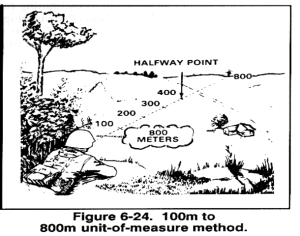Having a dead on rifle sight combination is crucial for accurate shooting; but so is knowing the arc of your bullet and how that round will react over known distances. The way to do this is to sight in your weapon on a range and shoot at known distance targets. That means tracking every single bullet at center mass. If your bullets are striking high then you know you need to aim waist level at near targets, and if your rifle is shooting low it lets you know if you need to aim and the throat, head, or above the target as you reach further out with your shots. Check out the rifle marksmanship program used by the USMC for some great information. The army is, unfortunately, lacking in this area in regards to the basic soldier.
After you know your weapon to a “T” and how the rounds will consistently react at various ranges, we need to figure out how to accurately estimate target distance so you can drop rounds accurately and not shoot low or high. In other words, since we don’t all carry laser range finders on us, we need a field expedient estimation method or two. If you have some other methods for estimating target distance please let us know.
Here are some considerations and responsive tips if you are being engaged from the Army Study Guide.
Football-field Method.
The length of a football field is 100 yards instead of meters, but it is a unit of measure most of you are familiar with. Estimate the number of football fields between you and the target for ranges up to 500 meters. Multiply the number of fields by 100 to determine the range in meters.
(b)For ranges between 500 and 1000 meters, pick a point halfway between you and the target. Determine the number of football fields7, multiply by 100, then double the mount to find the range to the target.
(c)In this example there are four to the halfway point, so multiply by 100 and double the amount and you will have the estimated range of 800 meters.
Factors which may affect target appearance.
Situations and conditions which may seem to make targets appear closer than they actually are:
- Bright, clear day.
- Sun in front of the target. The sun is behind you or over your shoulder as you are looking at the target.
- High elevations. The target is at a higher elevation than you.
Factors which may affect target appearance.
- Bright colors (white, red, yellow). The target is brightly colored.
- Large targets.
- Desert.
- At sea
Factors which may affect target appearance.
Situations and conditions which may seem to make targets appear further away than they actually are:
- Fog, rain, hazy twilight.
- Sun behind the target.
- Lower elevations.
- Small targets.
- Dark colors.
- Camouflaged targets.
Flash-to-Bang method.
This method only works if you can observe your target firing their weapon.
In this method, range is determined by counting the seconds between the time that you see the flash and when you hear the sound of the gun firing. You can count the seconds by counting one-thousand-one, one-thousand-two, and etc., with each count being one second. Since sound travels through the air at a speed of about 330 meters per second, each second you counted equals 330 meters.
Sound delay (“crack-bang”): The enemy’s supersonic bullets produce a sonic boom, creating a “crack” sound as they pass by. If the enemy’s bullet speed is known, his range can be estimated by measuring the delay between the bullet’s passing and the sound of the rifle shot, then comparing it to a table of values. This is only effective at distances of up to 450 meters; beyond this, the delay continues to increase, but at a rate too small for humans to distinguish accurately. Also, in urban areas, the sound can give inaccurate results because the buildings in the area can relay false sound directions.
Firing regulations for Small Arms for the US Army
The United States Army War Department put out this book, and here is an excerpt starting on page 62. Just so you know, the version I have is dated to 1904, so it’s old, but the techniques can still be useful.
- Appearance of a Man at Different Distances. The soldier should be taught that in judging distance from an enemy his estimate may be corrected by an observance of the following facet, which will be found true under ordinary conditions with the average eye:
At 30 yards the white of a man’s eye is plainly seen, and the eyes themselves up to 80 yards.
At 100 yards all the parts of the body are seen distinctly, slight movements are perceptible, and the minute details of the uniform can be distinguished.
At 200 yards the outlines of the face are confused and the rows of brass buttons look like stripes.
At 400 yards the face is a mere dot, but all movements of the legs and arms are still distinct.
At 600 yards details can no longer be distinguished, though the files of a squad, if the light is strong, can be counted.
At 800 yards the men in a squad cannot always be counted, not their individual movements distinguished.
At 1,000 yards a line of men resembles a broad belt; the direction their march can, however, be readily determined.
Quick Pistol Thought
One thing I pulled from that info is that with the army stating the maximum effective range of an M9 pistol is 50 yards; a good rough distance for many pistol shooters; if you can’t see the whites of a person’s eyes, they’re probably too far for a pistol shot. Same applies to a person threatening you.





Leave a Reply